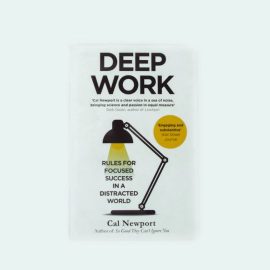

This article is an excerpt from the Shortform book guide to "Can't Hurt Me" by David Goggins. Shortform has the world's best summaries and analyses of books you should be reading.
Like this article? Sign up for a free trial here .
Looking for a Can’t Hurt Me book overview? How can David Goggins inspire you to overcome any challenge?
David Goggins is a former Navy SEAL and ultra-runner. In his book Can’t Hurt Me, he details his life from an overweight, pest control worker to one of America’s most highly-trained warriors. His goal is to show readers that, if you push yourself, you can overcome any obstacle that comes your way.
Here’s an overview of Goggins’s book.
Can’t Hurt Me
In the book Can’t Hurt Me, David Goggins describes his transformation from someone who let his circumstances control him to someone who proactively seeks greatness by tackling new challenges. He thinks everyone can work to cultivate a drive for self-improvement in order to overcome obstacles and reach their goals.
Goggins provides ten challenges to help people work efficiently toward their goals.
Challenge 1: Face Your Bad Hand
As you grow up, your life circumstances can affect your growth and development. Though it seems counterintuitive, acknowledging the difficult circumstances you’ve faced can be a good first step toward overcoming additional challenges—you can draw strength from your past successes.
An Abusive Father and School Struggles
For Goggins, acknowledging and overcoming his school struggles and his abusive father opened new doors. Before age 8, Goggins lived with his mother, father, and brother in Buffalo, New York. His father frequently beat all of the family members. Due to working nights at his father’s roller skating rink, 8-year-old Goggins fell behind in school.
Eventually, his mother sought help from a friend to get herself and her children to safety, escaping to live in her hometown of Brazil, Indiana. In Brazil, Goggins faced an unsupportive 3rd-grade teacher. He developed a stutter and began cheating to pass.
Take Action
To begin confronting the obstacles you currently face, take stock of the circumstances that have shaped your life, past and present:
- Start a journal. Paper or digital (on your laptop or phone) are both fine.
- List all of the difficult things you’ve faced or face in life. Ask yourself the following questions to jog your memory:
- What difficult circumstances did you face growing up? For example, you might have faced abuse or felt low self-esteem. Or, did you grow up without major challenges and therefore fail to learn to push outside your comfort zone?
- What kinds of challenges do you face now? For example, maybe a boss is limiting your progress at work, or you’re sabotaging yourself in some way from moving forward.
Challenge 2: Set Up Your Accountability Mirror
You may struggle to take actionable steps to reach your goals. In this challenge, break your goals into smaller steps, regularly work toward them, and keep yourself accountable to achieve success.
As a teen, Goggins continued to struggle with racism, school, and a longing to join the Air Force, but he didn’t want to use his struggles as excuses. So he devised a way to make his goals more manageable: writing Post-it notes of goals on his mirror to hold himself accountable for reaching them.
Racism
When Goggins lived in Brazil as a young kid, he’d been unaware of racism. This started to change when he and his mother later moved back to Brazil from Indianapolis and he faced a slew of harassment, including being threatened at gunpoint on a rural road. He struggled to understand how people could be so hateful. He also felt the loneliness of being one of the only black people in town.
Goggins didn’t know how to channel these emotions. He started trying to come up with ways to get a rise out of the racists around him, wearing unusual clothing, trimming his hair in odd ways, and blaring music from his car.
School Struggles and Air Force Aspirations
Though Goggins was now in high school, he still relied on cheating to pass school and was reading at the 4th-grade level. He wanted to join the Air Force but didn’t realize he’d need to pass an aptitude test. He was unable to cheat, and he didn’t pass on his first attempt.
Then, at the end of his junior year, Goggins received a letter that he wouldn’t graduate unless his attendance record and grades improved during his final year. This moment led him to a self-reckoning in his bathroom mirror. He felt frustrated with who he saw that day—a kid with few prospects who wouldn’t be able to make it into the Air Force without getting tough with himself and changing his behavior. He resolved to reach his goal of getting into the Air Force by improving his reading skills and studying for the test.
Each night, he wrote his goals for the next day down on Post-it notes and placed them on the mirror, his “accountability mirror.” Then, he’d make sure he worked toward his goals each day. He’d give himself a tough talk about the steps he needed to take and why. For example, he’d call himself out for being stupid and tell himself he needed to study to fix that. He found this method more motivating than being gentle with himself.
Using his accountability mirror to work toward his goals allowed Goggins to pass the Air Force qualifying exam and graduate from high school.
Take Action
An “accountability mirror” helps you break your goals and dreams into manageable steps and offers a visible reminder of what you’re working toward. It’s called an accountability mirror because it helps you hold yourself accountable for taking the steps necessary to achieve your goals.
Using Post-it notes or paper (rather than digital means), follow these steps:
- Write down all of your insecurities. Own your insecurities and use them as an opportunity to improve yourself.
- Write down all of your goals and dreams. Break them into small, specific steps, written on separate Post-it notes. Stick all your notes on the mirror. Hold yourself to working on them each day. The insecurities could inspire your goals, but don’t have to be related.
Challenge 3: Get Used to Discomfort
Developing the mental willpower to do things that you dislike or that make you uncomfortable is another powerful tool to achieve your goals.
Air Force Stint
Goggins entered the Air Force because he wanted to become a pararescueman: a member of the Air Force troops that rescue downed pilots. But he faced a large obstacle: training to swim and rescue people in the water. Goggins had never taken swimming lessons and could only do the most basic of strokes. He worried so much about failing that it nearly became a self-fulfilling prophecy.
Part-way through his swimming training, the Army doctors made Goggins pause his training after discovering that he had the sickle cell gene. At the time, they thought it could be life-threatening. Then, they reversed the decision: He could complete his training, but because he had missed some, he’d have to restart the training or transfer to another team.
The choice provided Goggins the reason to quit that he wanted after weeks of feeling like he wasn’t good enough to be a pararescueman. He was physically strong but didn’t have the mental willpower to start over and overcome this obstacle.
After his service, he continued to put on muscle but also fat, reaching 300 pounds. He worked a job in pest control and felt like he had no prospects.
Training to Become a Navy SEAL
One day, Goggins watched a TV program about the Navy SEALs and decided to apply, but he was told to get his weight down to below 191 pounds. He also needed to pass the same qualifying test he’d taken to get into the Air Force, but with a better score.
Goggins had 3 months to study and lose 106 pounds. He started exercising heavily, and if he skimped on any training, he made himself do the complete workout over again. He forced himself to do the work even when he didn’t want to. When he started doubting himself or feeling depressed, he realized he needed to redirect that energy into the exercise. He succeeded in losing the weight and passing the qualifying test.
Take Action
To push yourself toward your goals, learn to do things that make you uncomfortable. They can be related to your goals, but don’t have to be—building your tolerance for discomfort will prevent it from holding you back.
Here’s how to practice:
- Using your journal, write down things that make you uncomfortable or that you dislike doing. Or, consider writing down things you aren’t doing, but should be.
- Pick one and try doing it. Then, do it regularly.
- Encourage yourself to do something every day that you don’t like. Once something gets easier, make it more challenging.
Challenge 4: Best Your Opponent
When working toward your goals, it’s easy to sabotage your success by doubting yourself. For example, you might feel intimidated by your opponents—anyone who you think doubts your ability to succeed, and who makes you doubt yourself. This could be a boss, teacher, or coworker.
Instead, work to harness your feelings around that perceived doubt and use them to apply yourself and prove your opponent wrong.
Hell Week
Goggins needed to survive grueling training to become a SEAL. During Hell Week, the recruits are broken into teams and subjected to hours of physically demanding tasks.
Goggins realized that he wanted some tools to help him best his opponents—the officers leading them in the exercises who wanted them to fail. Toward the end of Hell Week, Goggins’s team was exhausted. Goggins knew that the men on his team needed to harness their remaining energy to keep going and exceed their superiors’ expectations, earning their respect. He reminded his team about how the officers wanted to break them down and encouraged them to find the energy to succeed and not give them the satisfaction. Goggins calls this “taking souls”—acknowledging your opponents and using your feelings toward them to fuel your best work, take them by surprise, and earn their respect.
Using these strategies, Goggins and his entire team survived Hell Week, with no one going home.
Take Action
Here’s how to use your feelings about your opponent to your advantage:
- Identify a challenge or competitive situation you face. For example, maybe you’re struggling to excel at work or get a good grade in math class.
- Identify the opponent you face in that situation. Maybe you’re struggling at work because your boss insists on micromanaging your every move, or maybe you feel like your math teacher doesn’t believe in you.
- Choose a project or other task you can do to showcase your skills. It could be creating a stellar proposal for work or getting a perfect score on an exam.
- Take the negative energy you have toward the obstacle or opponent and channel it to excel in your project. If you need to improve your skills to succeed, you might need to do things like studying more or working out outside of practice. Your ultimate goal is to amaze your opponent and earn their respect by vastly exceeding their expectations.
Challenge 5: Visualize Success
Learning to visualize the obstacles in your way and how achieving your goal will feel helps you keep going and address obstacles as they arise.
Hitting the Ground Running
After spending some time at home to recover from a knee injury, Goggins developed stress fractures in his shins and had 6 months to go before completing SEAL training. When he’d start to doubt himself, he’d give himself talks of encouragement—saying that the only guaranteed way to fail is to quit, and championing his personal strength for pushing through on broken shins. He also visualized how accomplished he’d feel when he completed training.
After he graduated training, he felt motivated to continue defying the odds completing the world’s toughest challenges.
Take Action
Practice visualizing your obstacles and successes with these two steps:
- Visualize a challenge or obstacle you need to overcome. Think about what it will look like and feel like when you do.
- Anticipate difficulty. Think about the obstacles you may face ahead of time and develop a plan to address them.
Challenge 6: Stock Your Cookie Jar
Another strategy to keep yourself working toward your goals even when you face obstacles is reminding yourself of your previous accomplishments. Goggins calls this collection of accomplishments your Cookie Jar.
San Diego One Day
While Goggins worked for the navy, he decided to raise money for the families of fallen soldiers by participating in ultra racing—running races longer than a marathon. He wanted to compete in the Badwater 135, a 135-mile race in California from the floor of Death Valley to the pinnacle of Mount Whitney.
To do so, he needed to compete in other ultramarathons first. He decided to compete in the San Diego One Day, but he was ill-prepared—in the previous 6 months, he had focused primarily on strength training and hadn’t run more than a mile at a time. By mile 70, he couldn’t go further.
After getting some assistance from his support team, he realized he could draw on another strategy to prevent him from quitting—his mental cache of past victories, or Cookie Jar. Thinking about his past victories and recognizing his toughness gave Goggins strength to finish the race.
Take Action
Here’s how to build your own cookie jar:
- Use your journal to write down your major life victories. Examples include exceeding a sales goal, running a half marathon, or convincing the city council to fund homelessness services.
- Write down all of the obstacles you’ve overcome, too. Examples include managing obsessive compulsive disorder, stopping smoking, or improving your relationship with your parents.
- As you work toward your goals, draw on this list to help you when you want to quit.
Challenge 7: Dismantle Your Governor
Cars have an internal regulator, or governor, that limits how fast they can go. Humans are the same way—our mental governor gives us feedback, telling us if we’re in pain or feeling insecure. Many people listen too readily and stop doing a task when they’ve applied only 40 percent of their effort, leaving 60 percent on the table. Pushing past the governor means pushing through pain, insecurities, and other things that make us want to quit before we’ve given our full effort.
The Hurt 100
Goggins learned how to manage his Governor as he competed in additional ultra races to qualify for the Badwater 135.
Despite Goggins’s physical preparation for a race called the Hurt 100, the course was still extremely demanding. He encountered three main challenges:
- His Camelbak, a water reservoir he could wear running, broke just 6 miles into the race.
- He wasn’t used to running on trails. Trails have more obstacles than a typical asphalt road, including rocks, tree roots, and mud.
- He was dealing with pain in his legs.
Goggins realized that he could convince himself to keep going by dividing the remainder of the race into chunks. He’d say things like, “I just want to get to the top of that hill, then I can quit.” But instead of wanting to quit, doing that inspired him to keep going.
Finding motivation to persist helped him dismantle his governor. By showing himself that he could keep going even when he didn’t want to, he adjusted his expectations of how far he could push himself.
He was able to finish the race, and later that same day, submitted his application for Badwater 135. The director told him he was accepted a few days later.
Badwater 135
Though he was arguably more prepared for this race than any he’d done before, Goggins still faced difficulty and wanted to quit. He became severely dehydrated about 7.5 hours in. To get through this, he worked to drink more water than he wanted, getting around his governor. (Shortform note: Sometimes, the thought of drinking a lot of water can be nauseating to a severely dehydrated person.) Ultimately, he came in fifth place.
Take Action
To learn to push past your natural stopping point, try these steps:
- Go as far as you naturally feel you can. For example, maybe you can run for 15 minutes.
- Once you think you’re at your max, coax yourself to go a bit further. Assess if you actually have energy to go further and talk to yourself about your specific next steps. For example, if you’ve already run 15 minutes and desperately want to stop, try to go another 2 minutes.
Challenge 8: Compartmentalize Your Time
People often think they need to have special talents to succeed in life. However, you often won’t be naturally talented at something. Instead, you need to schedule time every day to practice and hone your skills.
For example, the number one excuse people have for not exercising is that they don’t have enough time. But most people waste 4-5 hours a day doing things like watching shows or looking at social media. Compartmentalizing your time helps you make time for the activities that matter to you.
Becoming a Recruiter
Shortly after completing a long-distance triathlon, a Navy admiral reached out to Goggins. He wanted Goggins to recruit people of color for operations against the Taliban in northern Africa.
Balancing Recruitment With Life
To recruit more people of color, Goggins traveled to colleges and high schools across the country to speak. He learned to use himself as a prop to get students interested in his message. He’d run 50 miles to his speaking engagement and show up sweaty, or spend the first five minutes of his speech doing push-ups. He recognized that most people wouldn’t be interested in becoming a SEAL, so he worked to appeal to a broader swath of people, encouraging them to live to their fullest potential.
Goggins learned to compartmentalize his time to have time for work and athletics. For example, when he wasn’t traveling, he’d fit physical training into his daily schedule by running or biking to work. This allowed him to exercise and work 50 hours per week.
Take Action
Do this challenge over 3 weeks:
- In the first week, make detailed notes about how you spend each 15-30 minute chunk of your day. Note things like how much time you spend on your lunch break, how long your commute is, and whether you’re working without interruption or trying to multitask. Notice when you spend time that could be put toward working on your goals instead.
- For the second week, schedule out your time. Decide what you’re going to do with each fifteen- to thirty-minute chunk of time in your day. This includes exercise and rest. Some activities will require multiple chunks of time. Just make sure you’re not trying to squeeze multiple tasks into the same chunk—focus on one activity at a time. Continue taking notes about how you spend your time.
- For the third week, refine your schedule further based on your experience in the first two weeks. Ideally, you’ve arrived at a schedule that provides the maximum amount of time to do your important activities.
Challenges 9 and 10: Learn From Failure and Seek Greatness
Sometimes, we’re so scared of failing that we stop ourselves from even trying something. To avoid this, frame your failure as an opportunity to learn something so it feels less risky. Then, if you fail, you can evaluate the failure and refine your approach to reach your goal.
Once you’ve met your goal, push yourself to go above and beyond rather than settling to continuously improve yourself and achieve greatness that distinguishes you from others.
Breaking the Pull-Up Record
Goggins wasn’t content to be known just for his Navy career and ultra races. He realized that he did a lot of pull-ups as part of his regular training and wondered if he could break the world record for pull-ups in 24 hours.
It took him three tries to break the record. After each attempt, he evaluated what worked well and what needed improvement. He opted for a more private venue, a sturdier pull-up bar, and other fixes to diet and equipment to help him reach his goal.
Take Action
Learn to reflect on your failure with these steps:
- Think of a recent failure.
- Using a journal–on paper this time, if it isn’t already—ask the following questions to help you evaluate the failure:
- What did you do well as you prepared for and executed the failure?
- How did you handle the failure?
- How did the failure affect your relationships with others?
- How did it affect your life?
- What could you have done differently?
- (Optional) As soon as you can, schedule a time to make another attempt at the thing you failed at. If for some reason you can’t attempt the experience again, just do steps 1-2.
When you eventually reach your goal, it may be tempting to stop there. But many people operate this way. Instead, to set yourself apart from others, keep seeking new challenges rather than settling.

———End of Preview———
Like what you just read? Read the rest of the world's best book summary and analysis of David Goggins's "Can't Hurt Me" at Shortform .
Here's what you'll find in our full Can't Hurt Me summary :
- What a Navy SEAL says about pushing yourself to achieve greatness
- How to put in more effort to realize your potential
- The 10 challenges you can take on to reach your goals






